Monitor AP Status
You can monitor, reboot, upgrade, view and update the status of AP licenses, and complete many other actions on WatchGuard APs managed by your Firebox.
- Select Dashboard > Gateway Wireless Controller.
The Gateway Wireless Controller page appears. - Select the Summary tab.
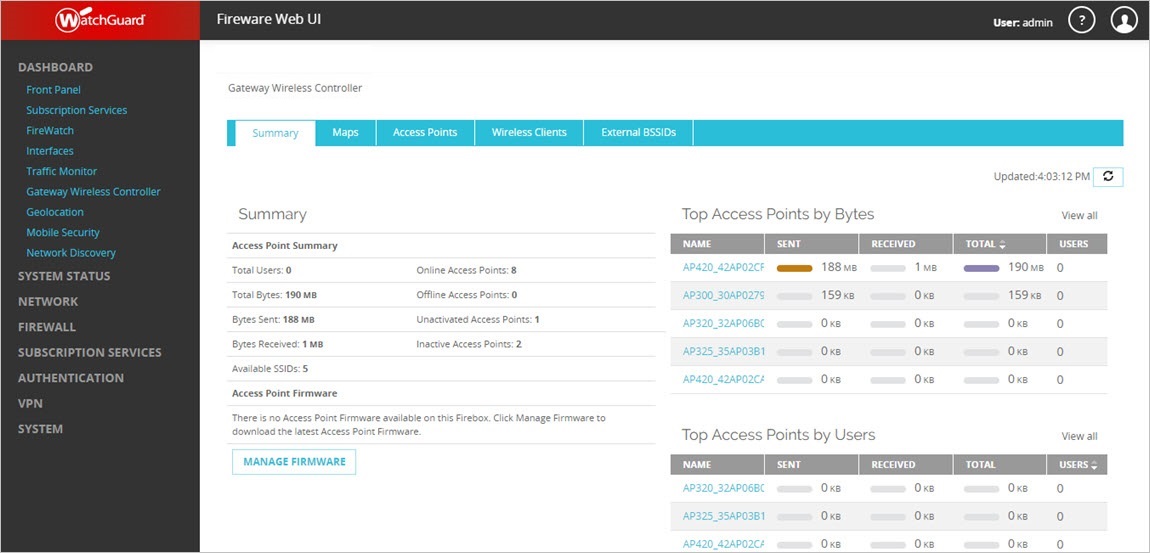
The Summary section shows a status summary for the AP and the available firmware version. The Top Panel sections show real-time data about the traffic through the AP.
- Select the Access Points tab.
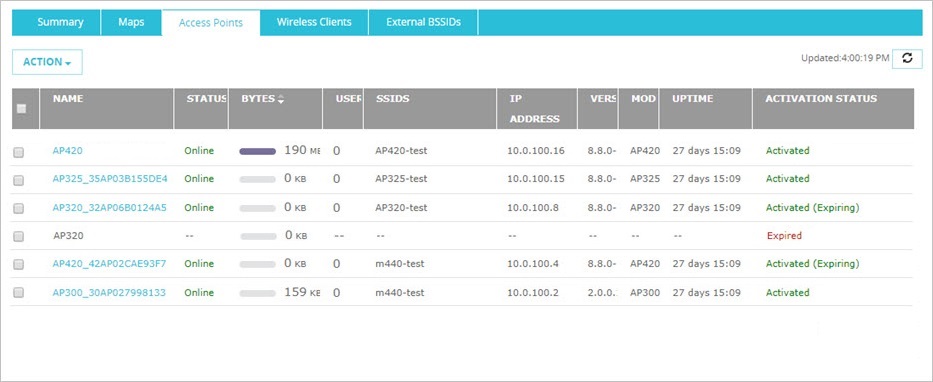
Click on an AP to see a pop-up window that shows detailed information about the AP.
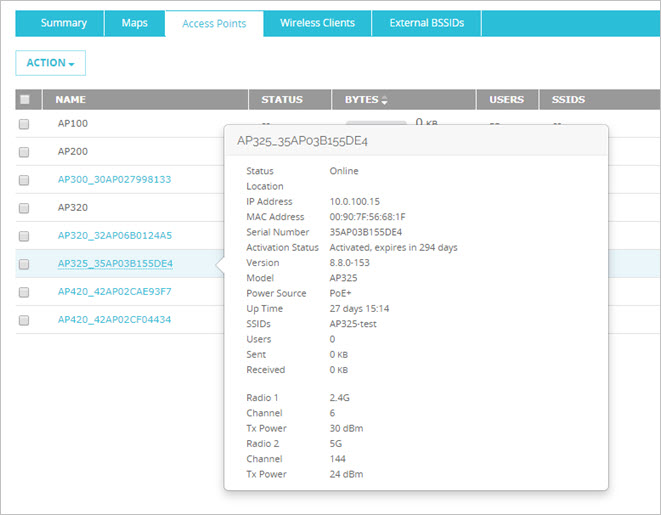
- Monitor your APs, as described in the next sections.
- Open Firebox System Manager for your Firebox.
- Select the Gateway Wireless Controller tab.
The Gateway Wireless Controller Summary and Detail information appears. - Select the Access Points tab.
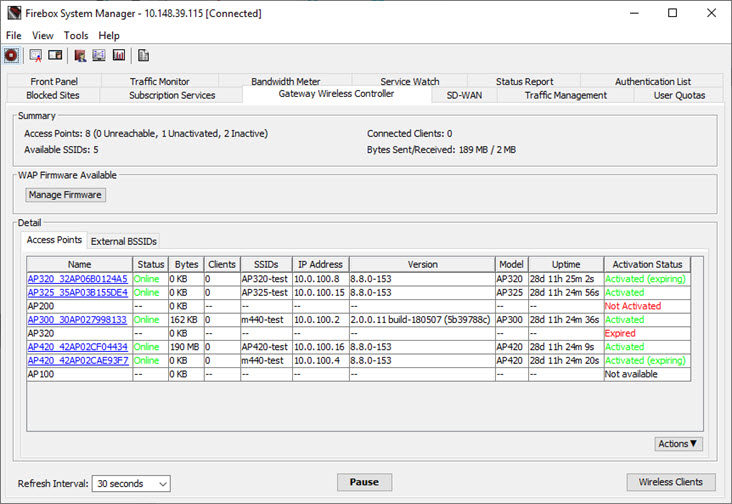
- Click on an AP to see a pop-up window that shows detailed information about the AP.
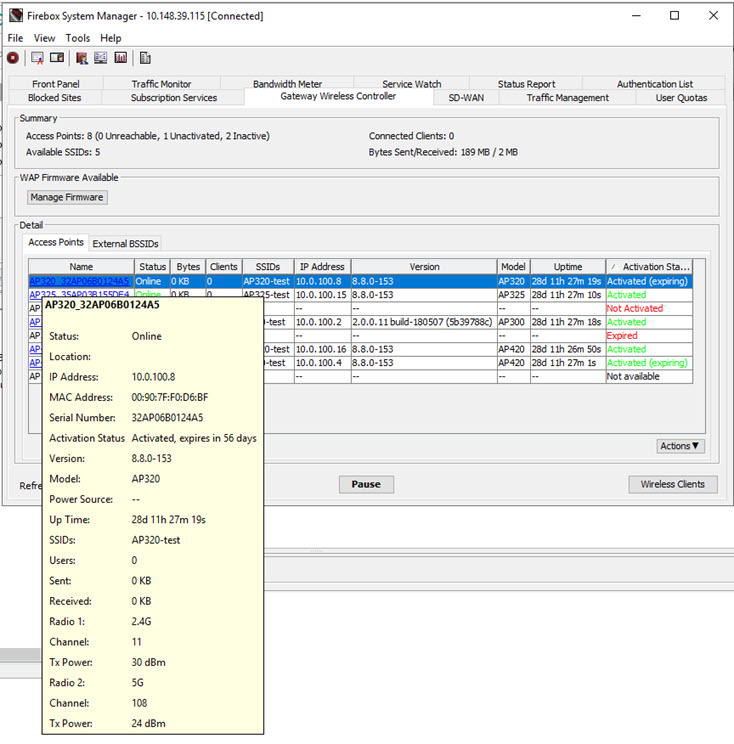
- Monitor your APs, as described in the next sections.
Monitor Access Points
From the Access Points tab, you can:
- See the connection status and uptime of each AP.
- See the radio frequency and channel used by each radio.
- See the power source used by an AP.
- See the transmit power and secondary channel information.
- See the AP activation and feature key status.
- See the log messages for the selected AP.
- See network statistics for the selected AP.
- Flash the power LED on the AP for identification.
- Reboot APs.
- Upgrade the firmware on APs.
- Trust an AP.
- Reset APs to factory default settings.
- Perform a site survey from a selected AP to detect other wireless access points.
See AP Connection Status and Uptime
In the Status column, you can see the status of each paired AP.
- Online — The AP is enabled and can communicate with the Firebox.
- Not Trusted — The AP is not in a trusted state. For more information, go to AP Trust Store.
- Unreachable — The AP cannot be contacted by the Firebox, or the AP is not able to connect to the Firebox on port UDP 2529.
- Discovered — The AP has been discovered by the Firebox, but is not yet online.
- Updating Firmware — The AP firmware is being updated.
- Updating Configuration — An update to the AP configuration is in progress.
- Authenticating — The AP is authenticating to the Gateway Wireless Controller. If the status does not change from Authenticating to Online, the passphrase on the AP might not match the passphrase on the Gateway Wireless Controller. For information about how to resolve a passphrase mismatch, go to About AP Passphrases.
- Cloud Managed — An AP on your network that is managed by WatchGuard Wi-Fi Cloud and not the Gateway Wireless Controller.
In the Uptime column, you can see how long an AP has been online.
For the Uptime to be correct, the Firebox must have a policy that allows NTP traffic from the AP to the Internet. For more information, go toWatchGuard AP Requirements and Limitations.
See AP Activation Status
(Fireware v12.5.1 and higher)
In the Activation Status column, you can view the license activation status for each AP:
- Activated — The AP is activated with a valid Basic Wi-Fi AP subscription. If you also manage Total or Secure Wi-Fi APs in WatchGuard Wi-Fi Cloud, the APs are displayed as (Activated: Total/Secure).
- Activated (Expiring )— The AP is activated with a valid AP subscription that expires in less than 90 days.
- Expired — The AP license is expired. The AP will continue to run in its last known configuration, but you cannot configure or monitor the AP until the license is updated.
- Not Activated — The AP has not been activated in your WatchGuard account. For more information, go to About AP Activation.
- Not Available — The Gateway Wireless Controller cannot determine the activation status. This status can occur when the Gateway Wireless Controller cannot communicate with WatchGuard servers.
For more information about AP licensing, go to About Gateway Wireless Controller AP Licenses.
Update AP Feature Key
(Fireware v12.5.1 and higher)
By default, the Gateway Wireless Controller automatically synchronizes the AP license status and AP feature key from WatchGuard servers. You can modify this option in the global Gateway Wireless Controller settings. For more information, go to Configure Gateway Wireless Controller Settings.
This synchronization occurs on a periodic basis to make sure the Gateway Wireless Controller has the latest activation status and AP feature key for your AP.
To immediately update the license status and AP feature key for an AP:
- Select Dashboard > Gateway Wireless Controller.
- Select the Access Points tab.
- Select an AP.
- Click Action.
- Select Get AP Feature Key to immediately retrieve the activation status and AP feature key from WatchGuard servers and update the Gateway Wireless Controller.
Select Update AP Feature Key to manually import an AP feature key to the Gateway Wireless Controller. You can view the AP feature key from your WatchGuard Support Center account. Copy and paste the feature key contents into the text box.
- Select the Gateway Wireless Controller tab.
- Select the Access Points tab.
- Select an AP.
- Click Actions.
- Select Get AP Feature Key to immediately retrieve the activation status and AP feature key from WatchGuard servers and update the Gateway Wireless Controller.
Select Update AP Feature Key to manually import an AP feature key to the Gateway Wireless Controller. You can view the AP feature key from your WatchGuard Support Center account. Copy and paste the feature key contents into the text box. - Click Yes to confirm.
See AP Power Source
You can view the type of power source in use by an AP:
- PoE+ (802.11at)
- PoE (802.11af)
- DC (Power adapter — If both DC and PoE power are in use, DC is displayed)
- -- (Not supported)
Power source indication is only supported on WatchGuard 802.11ac Wave 2 APs. 802.11ac Wave 1 and legacy APs will display "--" to indicate the ability to view the power source is not supported.
See AP Radio Frequency and Channel
In the Radio1 and Radio2 fields, you can see the frequency, channel, and transmit power used by each AP radio. If available, secondary channel information also appears.
Each radio automatically selects a quiet channel in the band you selected. The radio chooses an available channel that meets the requirements you specify in the Gateway Wireless Controller settings for the band, wireless mode, channel width, and country.
For more information about radio settings, go to Configure AP Radio Settings.
See AP Network Statistics
In the Sent, Received, and Total columns, you can see the number of kilobytes of data sent and received by each AP since the last time it restarted.
The Network Statistics report shows a more detailed collection of raw network statistics information from the selected AP. This includes the Interface Statistics (names, MAC and/or IP addresses, and traffic counters), the Routing Table, and the ARP table for the AP. This information can be helpful when you troubleshoot your AP configuration.
- Select Dashboard > Gateway Wireless Controller.
The Gateway Wireless Controller Dashboard page appears. - Select the Access Points tab and select an AP.
- From the Action drop-down list, click Network Statistics
The Network Statistics page appears with statistics from the selected AP. - To return to the main Gateway Wireless Controller page, click Back.
- Select the Gateway Wireless Controller tab.
- Select the Access Points tab and select an AP.
- From the Actions drop-down list, click Network Statistics.
The Network Statistics dialog box appears with statistics for the selected AP. - To update the statistics, click Refresh.
See Log Messages on an AP
By default, each WatchGuard AP saves recent syslog log messages locally. If you configure the AP to send syslog messages to an external syslog server, the recent syslog messages are also available on the AP.
- Select Dashboard > Gateway Wireless Controller.
The Gateway Wireless Controller Dashboard page appears. - Select the Access Points tab and select an AP.
- From the Action drop-down list, click Log Messages.
The Log Messages page appears with log messages from the selected AP. - To return to the main Gateway Wireless Controller page, click Back.
- Select the Gateway Wireless Controller tab.
- Select the Access Points tab and select an AP.
- From the Action drop-down list, click Log Messages.
The Log Messages dialog box appears with log messages from the selected AP. - To update the list of log messages, click Refresh.
- To close the Log Messages dialog box, click Close.
For the time stamp in the log messages on the AP to be correct, the Firebox must have a policy that allows NTP traffic from the AP to the Internet. For more information, go toWatchGuard AP Requirements and Limitations.
Flash the Power LED on the AP
You can flash the power LED on a specific AP to help with identification. This utility is useful after you select the Disable LEDs option and operate your AP in stealth mode to hide the use of wireless activity.
This feature is supported only on AP100, AP102, AP200, and AP300 devices.
For more information on how to disable the LEDs on your AP, go to Configure AP Settings.
- On the Access Points tab, select an AP
- From the Action drop-down list, click Flash Power LED.
The power LED flashes green for several minutes.
- On the Access Points tab, select an AP
- From the Actions drop-down list, click Flash Power LED.
The power LED flashes green for several minutes. - Type the Firebox configuration passphrase.
- Click OK.
Reboot APs
You can reboot a specific AP or select multiple APs and reboot the selected devices at the same time if they are online.
When you reboot a device, the configuration is reloaded and automatic channel selection occurs.
To schedule automatic reboots, go to Configure Gateway Wireless Controller Settings.
- On the Access Points tab, select one or more APs.
- From the Action drop-down list, click Reboot.
- Click Yes to confirm that you want to reboot.
- On the Access Points tab, select one or more APs.
- From the Actions drop-down list, click Reboot.
- Type the Firebox configuration passphrase.
- Click OK.
While an AP reboots, Unreachable appears in the Status column for the AP. When the AP reboot is complete, Online appears in the Status column.
You can also use the reset button on the AP to reboot it. To reboot the AP, press the reset button briefly (less than 5 seconds) and release.
Upgrade APs
From Fireware Web UI, you can see information about the installed and available versions of AP firmware the Gateway Wireless Controller Dashboard page. For more information, go to Monitor AP Status.
From Firebox System Manager, you can see information about the installed and available versions of AP firmware in the Gateway Wireless Controller. For more information, go to Monitor AP Status.
To manage the AP firmware available in the Gateway Wireless Controller on your Firebox, click Manage Firmware. For more information, go to Update AP Firmware on the Gateway Wireless Controller.
You can select a specific AP or select multiple APs and upgrade the selected devices at the same time if they are online.
- On the Access Points tab, select one or more APs.
- From the Action drop-down list, click Upgrade.
- Click Yes to confirm that you want to upgrade the AP.
- On the Access Points tab, select one or more APs.
- From the Actions drop-down list, click Upgrade.
- Type the Firebox configuration passphrase.
- Click OK.
While an AP reboots, Unreachable appears in the Status column for the AP. When the AP reboot is complete, Online appears in the Status column.
Do not interrupt the power to the AP while a firmware upgrade is in progress. Interruption of power during a firmware upgrade can cause the AP to start in failsafe mode. When the AP starts in failsafe mode, the Access Point web UI on the AP provides a single option that enables you to upgrade the device firmware. For more details about AP failsafe mode and recovery, go to the WatchGuard Knowledge Base.
Trust an AP
To help prevent potential security issues from factory reset, unauthorized, or compromised APs, the Gateway Wireless Controller does not manage or monitor an AP that is not trusted. For more information, go to AP Trust Store.
To trust an AP:
- Select Dashboard > Gateway Wireless Controller.
- Select the Access Points tab.
- Select one or more APs.
- Click Action.
- Select Mark Trusted.
Reset Trust Store
If any of your APs might have been compromised, for example, if APs have been tampered with, reset, or are no longer under your control, we recommend that you reset the Trust Store.
For more information, go to AP Trust Store.
Show Password
(Fireware v12.0.2 or lower)
If automatic passphrase management is enabled, you can show the AP passphrase.
To see the passphrase:
- Select an AP.
- Click Action.
- Select Show Password.
For more information, go to About AP Passphrases.
Reset APs to Factory-Default Settings
You can reset an AP to factory-default settings from the Gateway Wireless Controller. The APs are unpaired after they are reset.
To reset an AP:
- Select Dashboard > Gateway Wireless Controller.
- On the Access Points tab, select an AP.
- From the Action drop-down list, select Reset to Factory Default.
Complete a Site Survey
You can use your AP to complete a site survey to detect other wireless access points that operate in the same area. When you complete a site survey, the radios in the AP scan the wireless channels to find other wireless access points. The site survey can detect all local wireless access points. This includes other WatchGuard APs and WatchGuard Firebox wireless devices. You must configure an AP radio with at least one SSID before that radio can run a site survey scan.
When a site survey scan begins, the AP scans the airwaves within range for other radio broadcasts in the same radio band, on all available wireless channels. The scan is not limited to the wireless mode and channel settings configured in the radio settings of your device. Dual radio devices can use both radios to scan on the 2.4GHz and 5GHz radio bands. A single radio device scans on either the 2.4GHz or 5GHz band. The band used for the scan depends on which band the radio is configured to operate in.
The site survey does not interrupt wireless connectivity for connected wireless clients.
- Select Dashboard > Gateway Wireless Controller.
- On the Access Points tab, select an AP.
- Click Site Survey.
The Site Survey page appears and the AP begins the scan for other wireless access points. A list of detected access points appears in the Site Survey page.

- To return to the main Gateway Wireless Controller Dashboard, click Back.
- On the Access Points tab, select an AP.
- Click Site Survey.
The Site Survey dialog box appears and the AP begins to scan for other wireless access points. A list of detected access points appears in the Site Survey dialog box.
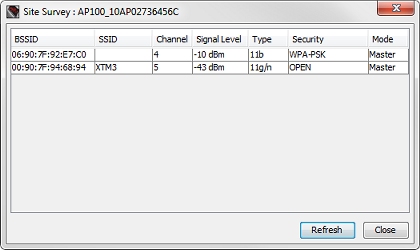
- To update the list of scan results from the AP, click Refresh.
For each detected wireless access point, the site survey report includes this information:
BSSID
The Basic Service Set Identifier is the MAC address of the wireless access point.
SSID
This is the SSID for the access point. If an access point has more than one SSID, each SSID appears as a separate item in the site survey.
Channel
This is the wireless channel that the wireless access point uses. If available, secondary channel information also appears.
Signal Level
This is the signal strength of the wireless access point.
Type
This is the wireless standard the wireless access point supports.
Security
This is the type of wireless security used by the wireless access point.
Mode
This is the operating mode of the wireless device.